The University of California (UC) includes eight general campuses and one health science campus. The budget proposes General Fund expenditures of $1.9 billion. This is an increase of $63 million, or 3.5 percent, from estimated current-year expenditures. The General Fund increase is primarily for unspecified general purposes and additional costs for lease-payment bonds. The budget does not propose an enrollment level. It does, however, anticipate a fee increase of at least 10 percent.
We recommend that the Legislature take a variety of actions--in line with the principles we identify--in crafting a budget plan for the UC.
We have developed budget proposals for the UC and the California State University (CSU) based on several principles that we discuss in an earlier section on higher education crosscutting issues. Figure 23 shows our proposal for the UC in detail, compared to the Governor's proposal. As the figure shows, our recommendations result in no net General Fund increase above the level proposed by the Governor. Below, we discuss individual recommendations for each item where our proposed funding level differs from the Governor's funding level.
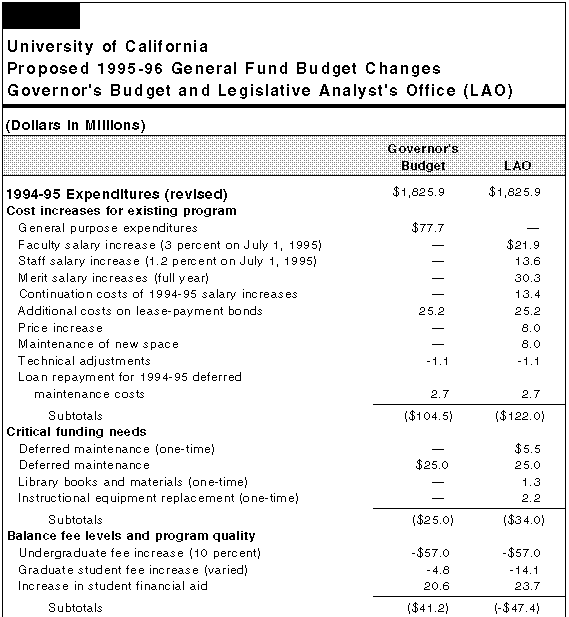
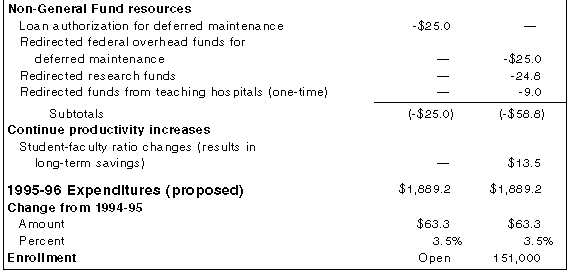
We recommend expenditures of $79.2 million to provide a 3 percent faculty salary increase, a 1.2 percent staff salary increase, and merit salary increases for UC faculty and staff on July 1, 1995, and fund the continuation costs of salary increases provided in the current year.
The Governor's Budget does not specifically provide for faculty and staff salary increases or merit salary adjustments (MSAs). At the time of this analysis, the UC administration was proposing to allocate $13.4 million for the continuation costs of compensation increases granted in 1994-95. The UC administration was also proposing to allocate $59.4 million for additional compensation increases in 1995-96, which represents an overall increase of 3.2 percent.
In past years, the Legislature has sought to achieve a balance among various types of compensation increases. For example, the Legislature has provided funds both for general salary increases and for merit salary increases. With regard to faculty, the Legislature has been concerned about the extent to which the provision of any salary increases and MSAs would narrow or eliminate the gap between faculty salaries at UC in relation to the UC's comparison institutions. (As we discussed earlier in the higher education crosscutting issues section, our analysis indicates that UC faculty salaries would lag behind comparison institutions by 7.7 percent in 1995-96 in the absence of salary increases.)
We believe that providing an increase of roughly the amount proposed by the UC administration would be a reasonable step towards reducing the faculty salary gap we identify, given the fiscal constraints facing the Legislature. Consistent with past legislative action to provide funding for merit salary adjustments and balance various types of compensation increases, we recommend an expenditure of $68.5 million for employee compensation increases in the budget year, allocated as follows: $21.9 million for 3 percent general faculty salary increases, $13.6 million for 1.2 percent general staff salary increases (the same percentage we recommend for CSU staff), and $30.3 million for merit salary increases for faculty and staff. We also recommend an expenditure of $13.4 million for the continuation costs of salary increases granted in the current year. This increase is consistent with the Legislature's intent as specified in the Supplemental Report of the 1994 Budget Act.
We recommend an expenditure of $16 million for price increases and maintenance of new space.
The Governor's Budget does not address various costs of continuing existing programs at the UC.
We recommend the expenditure of $34 million in the critical areas of deferred maintenance, instructional equipment replacement, and library materials.
The Governor's Budget does not propose any funding changes in the areas of instructional equipment replacement (IER) and library materials. The budget provides authority for a $25 million loan for deferred maintenance. We recommend the expenditure of $34 million to address the highest priority needs in the areas of deferred maintenance, IER, and library materials. We discuss each of these areas below.
Deferred Maintenance. For 1992-93 (the most recent year for which detailed information is available), the UC's deferred maintenance backlog was approximately $348 million. The backlog of priority-one projects was $142 million. Priority-one projects are generally defined as those requiring "immediate action to return a facility to normal operation, stop accelerated deterioration, or correct a cited safety hazard." The 1992-93 deferred maintenance backlog for each campus is displayed in our Analysis of the 1994-95 Budget Bill, (please see p. F-29).
In 1994-95, the budget provides $36 million for priority-one deferred maintenance projects at UC campuses. Of this amount, $25 million was specified in the 1994 budget package as being from lease-payment bonds for priority-one deferred maintenance projects that would have an anticipated useful life of 15 years. Due to recent legal developments (which we discuss in a later section of this analysis), however, the UC is planning to use a loan instead for the projects. The remaining $11 million is from a redirection of teaching hospital excess gains, as specified by the Legislature in the Supplemental Report of the 1994 Budget Act. The backlog of priority-one projects as well as the overall backlog will continue to be significant in 1995-96. An additional $30.5 million ($5.5 million in one-time funds and $25 million in ongoing funds) would address a small portion of the shortfall.
Instructional Equipment Replacement. In the current year, the UC estimates that it will spend approximately $31 million for IER. This is one-half of the IER need as determined by the IER formula adopted by the Legislature in 1984. By 1995-96, the accumulated shortfall since 1990-91 will be $139 million. We believe that state-of-art equipment is essential for instruction, especially in engineering and the sciences, because of rapid technological advances requiring expensive, high- demand equipment. An additional $2.2 million in one-time funds can be used to address the most critical areas.
Library Materials. In the current year, the budget includes approximately $53 million for library books and materials. The UC estimates that the current-year amount falls short of the amount needed by approximately $24 million. The addition of the $1.3 million in one-time funds we recommend would address a small portion of the shortfall.
The $9 million in one-time funds for deferred maintenance, IER, and library materials would come from the second year of a planned redirection from teaching hospital excess gains, as was provided for in supplemental report language to the 1994 Budget Act. The $25 million in ongoing funds for deferred maintenance would come from redirected federal overhead funds used instead of the loan authorization proposed in the Governor's Budget. We discuss these issues later in this analysis.
We recommend that undergraduate student fees be increased by $380 (10 percent)--from $3,799 to $4,179.
The Governor's Budget anticipates that student fees at UC will increase by at least 10 percent. The UC administration is proposing an undergraduate fee increase of $380 (10 percent). At the time of this analysis, the UC regents had not acted on this proposal.
We recommend an increase in the general undergraduate student fee of $380 (10 percent). We believe this is a reasonable increase given the state's fiscal condition and the level of UC fees relative to those at its comparison institutions. Figure 24 shows fees (including the mandatory fee and campus-based fees) in 1994-95 for undergraduates and graduates. It indicates that UC undergraduate fees are approximately $241 below the UC's four public comparison universities. More specifically, our review indicates that the UC's undergraduate fees in the current year place the UC in the middle of the range of its four public compar-ison universities. Even with the proposed increase, UC undergraduate fees will continue to be near the average.
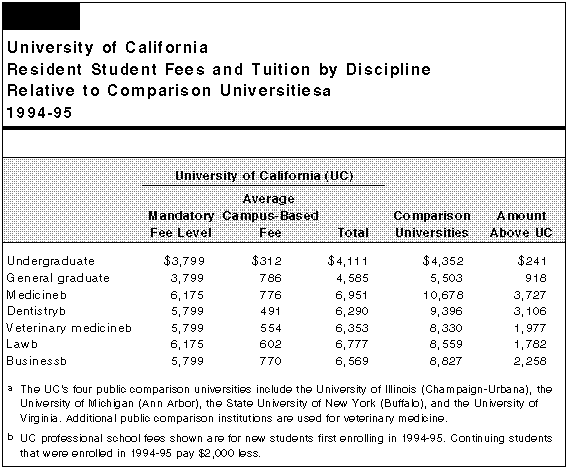
As we discuss earlier in the higher education crosscutting issues section, we took as a starting point the administration's total proposed funding levels for higher education in developing our alternative budget proposals. To the extent the Legislature increases the overall level of support for higher education, moderating the fee increase may be a high legislative priority. To assist the Legislature in its deliberations on this issue, we note that $38 million would be needed in 1995-96 to provide UC with the same level of resources as is provided by a 10 percent fee increase (net of financial aid).
We recommend that graduate student fees be increased by amounts ranging from $200 to $4,376 above the general fee increase for undergraduates.
The Governor's Budget does not propose a specific fee increase for graduate students. Figure 25 displays the UC administration's proposal for graduate students in selected professional programs.
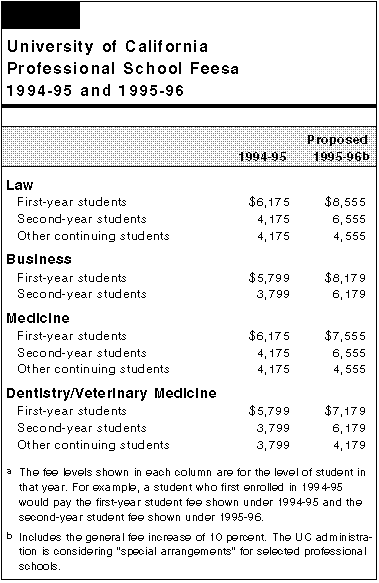
In the Supplemental Report of the 1994 Budget Act, the Legislature expressed its intent that the UC increase fees for students enrolled in selected professional programs (medicine, dentistry, veterinary medicine, law, and business) over a five-year period to the average of fees charged by comparable public universities.
We recommend that all graduate students pay the general increase of $380 that we recommend for undergraduates. We further recommend that these graduate students (except for those in professional schools) pay an additional $200.
There are several ways to move towards the Legislature's goals for students in selected professional schools discussed above. The UC administration's proposal as shown in Figure 25 is one reasonable approach and we recommend that it be adopted. We believe that these recommendations are generally consistent with the Legislature's intent as described above, and are sound for the following reasons:
We also believe that the state's charges for graduate studies should not be so high as to disadvantage California in relationship to other states in competition to attract highly qualified students. To examine this issue, we reviewed graduate studies charges at comparable public universities. Figure 24 shows that UC charges for general graduate students are $918 below the average charge at the UC's four comparable public universities. The difference is much greater for selected professional programs. For example, UC charges for students enrolled in medical degree programs are $3,727 below the average charge, while UC charges for business (MBA) students are $2,258 below the average charge at comparable universities.
Report Due in March 1995. In the Supplemental Report of the 1994 Budget Act, the Legislature "strongly encourages the UC to develop programs to ensure that no professional school student wishing to pursue a career in the public sector is prohibited from doing so because of the burden placed upon them by any differential fee." The UC's report on this issues is due to the Legislature by March 1, 1995. We will comment on it, as appropriate, during budget hearings.
We recommend the expenditure of $23.7 million for additional student financial aid for needy students to offset our recommended fee increases.
This aid amount is equal to 33 percent of the total fee increase and should be sufficient to offset the fee increase for needy students. In our analysis of the Student Aid Commission, we recommend approval of a proposed $11.5 million increase to offset the impact of the 10 percent fee increase on Cal Grant award winners.
We recommend redirection of $9 million of teaching hospital net gains to fund campus-based programs, consistent with previous legislative actions.
Background. Last year we concluded that the UC teaching hospitals had net gains that exceeded the five percent level we identified as being needed for equipment and capital outlay purposes. We recommended that the UC reallocate teaching hospital net gains in excess of 5 percent of net operating revenues from the hospitals to the campuses, and dedicate the funds towards critical campus funding needs in the areas of deferred maintenance, instructional equipment replacement (IER), and library materials. The Legislature adopted our recommendation and in the Supplemental Report of the 1994 Budget Act provided that $18 million be redirected for these purposes in 1994-95, with an additional $17 million to be redirected in 1995-96. These $35 million in excess gains were realized in 1992-93 and 1993-94.
Our review of updated information indicates that the amount of net gains above the five percent level that will be available for redirection in 1995-96 is $9 million, rather than the $17 million anticipated last year. This is due to several factors, including declines in the number of patient days and increases in medical malpractice insurance costs.
We recommend that the $9 million be redirected for one-time expenditures in the areas of deferred maintenance, IER, and library book purchases, as provided in the following proposed supplemental report language:
It is the intent of the Legislature that, for 1995-96, the University of California redirect $9 million of clinical teaching support funding on a one-time basis to fund the following program areas: $5.5 million for deferred maintenance, $1.3 million for libraries, and $2.2 million for instructional equipment replacement. Supplemental language in 1994-95 recommended that $17 million be redirected for 1995-96; however, this amount is reduced to $9 million in recognition of updated information regarding the decrease in net gains for 1993-94.
Potential Additional Redirections. The UC's current projections for the immediate future indicate that the UC teaching hospitals will no longer achieve net gains above five percent. This is due to significant changes in public and private health care payment systems that are anticipated to result in decreases in the total number of patient days and payment rates for each patient-day. For planning purposes, however, we continue to believe that it is reasonable to redirect teaching hospital gains exceeding five percent for campus needs in the future. Thus, we recommend that the Legislature adopt a plan for redirecting net gains above five percent, if any, that are realized in 1994-95. (These gains would most likely be allocated in late 1995-96.)
Specifically, we recommend the adoption of the following supplemental report language:
The UC's current projections for 1994-95 and for several years thereafter indicate that UC's teaching hospitals will experience financial difficulty due to a variety of factors, including an expected decline in the number of patient days; a decrease in the rate of reimbursement from Medicare, Medi-Cal, and disproportionate provider payments; and changes expected because of the emerging managed care environment. Consequently, these projections indicate that UC hospitals will no longer achieve net gains above five percent. However, in the event the fiscal difficulties do not materialize, it is the intent of the Legislature that any amount over a net gain of five percent for the UC system (excluding the Irvine hospital) for 1994-95 should be redirected to the same programs in the same proportions as specified above. Later in this analysis, we discuss longer-term issues related to the teaching hospitals.
To avoid debt financing for ongoing deferred maintenance needs, we recommend that the Legislature reject the budget proposal to authorize a $25 million loan for deferred maintenance in 1995-96, and fund these critical deferred maintenance projects instead through a redirection of $25 million in federal overhead receipts.
The budget provides $2.7 million in 1995-96 for the UC to begin repayment on $25 million in loan funds that the budget anticipates the UC will borrow for deferred maintenance needs in 1994-95. The budget also authorizes the UC to obtain an additional $25 million loan for deferred maintenance in 1995-96, and suggests that similar annual loans would be made thereafter. The loan would be paid off over a 15-year period from General Fund payments.
Background. In the 1994 Budget Act and related legislation, the Legislature provided $25 million from lease-payment bonds for deferred maintenance projects (such as roof replacements). Roughly $10.5 million of this amount was to replace existing General Fund expenditures for deferred maintenance. The remainder was provided by the Legislature to offset General Fund reductions and redirections totalling about $14.5 million. Debt payments on the bonds would be made from an annual General Fund appropriation to the UC.
Typically, lease-payment bonds have been used for long-term capital improvements and not for deferred maintenance purposes, which have been funded as part of ongoing state operations. Given this departure, the Legislature adopted various provisions in the 1994 budget package regarding these bonds. First, the Legislature specified that the bonds were to be used for deferred maintenance projects with a useful life of at least 15 years. The Legislature also specified that the projects were to be "priority one" projects, which are those requiring "immediate action to return a facility to normal operation, stop accelerated deterioration, or correct a cited safety hazard."
Finally, the budget package provided for an "asset transfer" mechanism to ensure that sufficient "collateral" was available to back-up the sale of the bonds. Asset transfer involves identifying an asset of sufficient value to support the amount of bonds to be sold. Under this mechanism, the asset identified may bear no relationship to the deferred maintenance projects being undertaken, though the total value must generally be in the same range as the projects. For example, an existing building (on one campus) valued at $15 million may be identified through asset transfer as the collateral for lease-payment bonds, but the projects undertaken using the bond monies may be the replacement of 15 new building roofs (throughout the 9 campuses) at an average cost of $1 million each.
Under current law, the state Attorney General is responsible for determining whether a proposed use of lease-payment bonds meets various legal requirements, such as constitutional requirements related to debt. Since enactment of the budget package, the Attorney General has raised concerns that the proposed use of lease- payment bonds (and particularly the asset transfer provisions) may not meet various legal requirements. As of late-January 1995, the Attorney General had not made a positive determination that the use of $25 million in lease-payment bonds for deferred maintenance meets legal requirements.
Debt Financing Not Prudent. In our view, proposed debt financing of the UC's operating budget in 1995-96 is ill-advised because prudent budget policy calls for annual balancing of the UC budget. If the state provides new loans each year for the indefinite future, it will have to pay these loan amounts--plus interest--out of future years' operating budgets. We believe the state should recognize this ongoing cost and provide for it in the ongoing budget.
There are two major alternatives to borrowing funds for deferred maintenance: (1) make further reductions in planned expenditures and shift the freed-up monies to fund deferred maintenance and/or (2) identify other revenue sources besides a loan. As Figure 23 earlier in this analysis shows, virtually all the UC's planned expenditures are to (1) pay for continuing costs of operating the current program (including compensation costs needed to maintain the UC's competitiveness with other educational institutions), or (2) pay for staff-ratio changes that will ultimately save money. Thus, it would be difficult to reduce the planned expenditures by the $25 million necessary to avoid the planned borrowing. The other possibility is to identify additional revenue. In our review, we have identified $25 million in revenues from federal overhead receipts that could be redirected to avoid the loan.
Accordingly, we recommend that the Legislature reject the proposed authorization for a $25 million loan for deferred maintenance in 1995-96. We recommend instead that a like amount of funds be redirected from federal overhead receipts for this purpose. (We discuss our detailed recommendations regarding federal overhead funds in the next section.)
We recommend that the Legislature direct the UC Regents to enter into a new agreement with the state Department of Finance regarding federal overhead funds to (1) better account for the UC's direct costs of administration, (2) direct specific funds towards critical deferred maintenance needs, and (3) increase the state's share of the remaining funds.
The budget estimates that the UC will receive federal overhead receipts totalling $268.8 million in 1995-96. Based on current policy, $116.3 million of these receipts will be used to offset the UC's General Fund budget. This represents 55 percent of the total receipts after allowance for grant administration and related activities.
Background. The UC is the primary research university in the state. Its annual research program is approximately $1.4 billion in the current year. Of this amount, about $799 million (56 percent) is federally funded. In recognition of the university's costs related to utilities, building amortization, grant administration, and certain indirect costs, the federal government pays the UC a negotiated overhead allowance on each grant. The percentage of overhead paid on each grant varies due to unique differences.
Prior to 1967, federal overhead receipts were not of significant magnitude; consequently, the university retained all overhead receipts. By 1967 the magnitude of overhead receipts was significant and the state sought to share the federal income. Sharing by the state was justified on the basis that state tax dollars paid for much of the UC's physical plant and personnel (especially faculty salaries); consequently, the state should share in the income derived from such an investment. On the other hand, the UC argued that it should continue to receive a major share of the income to pay its direct costs of grant administration and maintain its entrepreneurial incentive to acquire additional grants.
A memorandum of understanding was negotiated in 1967 by the Department of Finance and approved by the Legislature that provided for the state and the UC to share overhead receipts on a 50/50 basis after allowance for administration and related activities. This memorandum was amended in 1979 to increase the state's share to 55 percent. The UC share provides the funding source for the Regents' Opportunity Fund. Figure 26 shows actual and estimated overhead receipts, and revenues to the Regents' Opportunity Fund, from 1990-91 through 1995-96. It shows that about two-thirds of the fund revenues go to support research activities.
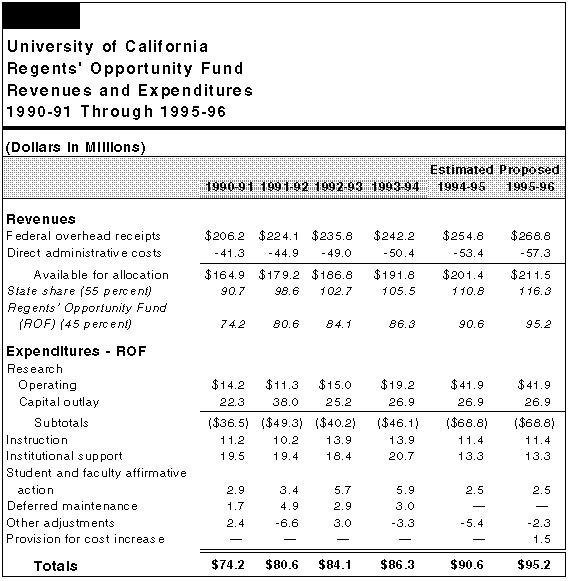
Previous Recommendation. Two years ago, we recommended as part of a package of changes affecting the UC that the state share of federal contract and grant overhead receipts be increased. Our recommendation was based primarily on the state's legitimate claim to receive reimbursement for costs it had earlier incurred. We also noted, however, that a reallocation of overhead receipts was justified because the UC's overall research budget had increased, even at a time when General Fund support had declined and student fees had increased significantly. We recommended that the funds freed up as a result of this recommendation be redirected to address critical funding needs at the UC. This recommendation was not adopted; the Legislature instead chose to augment the UC budget to address the funding needs.
Current Situation. We continue to believe that a reallocation of federal overhead receipts to other critical needs within UC is justified for the reasons discussed above. We also believe that the federal overhead formula should be changed to address other technical issues related to changes in federal rules regarding grant funding. Specifically, we recommend that the allocation of federal overhead funds be modified to:
Figure 27 displays the effects of our recommendation, which we discuss below.
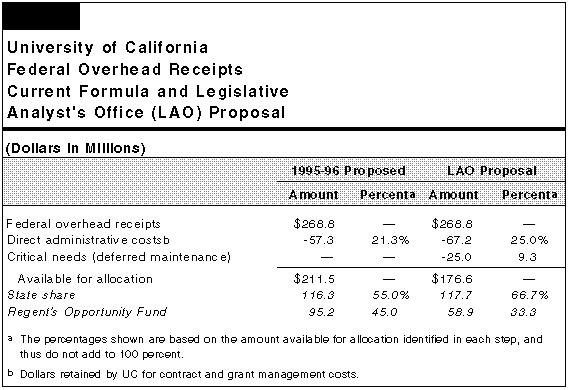
Direct Administration Costs. The federal government is phasing-in changes to its grant funding practices so that ultimately it will no longer pay for certain administrative costs (such as clerical support) as part of the direct costs of each grant. Instead, the federal government is anticipating that these costs would be funded through federal overhead receipts. The UC indicates that the amount of these "disallowed" charges could be ultimately in the range of $10 to $20 million though detailed data will not be available until after the full phase-in of new federal procedures is completed over the next several years. Currently, the UC is paying these costs through the use of short-term budget solutions. In the long run, we believe the state should recognize the actual administrative costs by allocating additional federal overhead receipts for direct administrative costs.
Currently, the UC retains roughly the first 20 percent of overhead receipts for contract and grant management costs (referred to as the "off-the-top" allocation). We recommend instead that the "off-the-top" amount be increased to 25 percent, which would provide roughly an additional $10 million to the UC to better reflect actual administrative costs.
Allocation For Deferred Maintenance. To avoid the proposed $25 million loan for deferred maintenance discussed in an earlier section, we recommend that $25 million of federal overhead revenues be taken off the top and, for the reasons discussed above, redirected for deferred maintenance needs on the campuses.
State Sharing Ratio. In order to ensure that the amount of the state share will not decrease as a result of acknowledging the UC's direct administrative costs and redirecting overhead funds for deferred maintenance, we recommend that the state share be increased from 55 percent to 66.7 percent. There is no particular analytical method for determining what the appropriate state share should be (and in fact the current 55 percent share is not based on a particular analytical rationale). As we noted earlier, the state provides the initial investment in faculty salaries and infrastructure that is then reimbursed through federal overhead receipts. Thus, a case could be made that all federal overhead funds should be reimbursed to the General Fund. However, the provision of some share to the UC may provide an incentive to negotiate favorable overhead rates with the federal government. We believe that increasing the state's share on the remaining balance to 66.7 percent would still provide the UC with such an incentive.
We recommend redirection of $24.8 million of General Fund research support to address instruction-related costs, such as the gap in UC faculty salaries compared to similar institutions and planned investments in the student-faculty ratio that will ultimately result in long-term savings.
The budget proposes $181 million in General Fund support for UC research programs in 1995-96. The UC estimates that it will spend roughly $172 million (General Fund) for research in the current-year.
Figure 28 displays expenditures for organized research at the UC from 1990-91 through 1994-95. All the expenditures shown for the current year are estimates. If past spending trends continue, actual expenditures are likely to differ from the estimates.
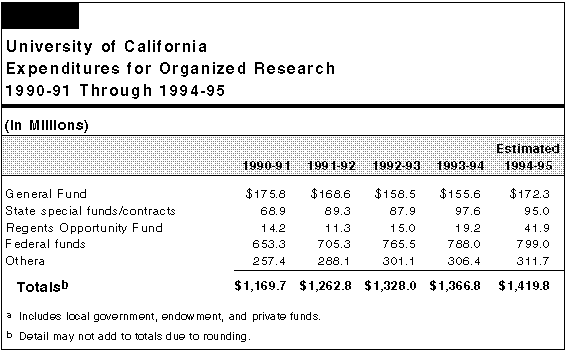
As the figure shows, overall expenditures for UC research have increased from $1.2 billion in 1990-91 to an estimated $1.4 billion in 1994-95, an increase of $250 million, or 21 percent.
Figure 28 shows that federal funds are the UC's single most important source of support for research, accounting for about 56 percent of all university research expenditures. General Fund support is more important that its relative share (12 percent) would indicate for several reasons. According to the UC, state funds often provide the core level of investment needed in a research area to attract federal and other extramural support. Second, for some research fields in which there are few sources of federal or other support, such as in the arts and humanities, state funds may represent the major support available.
While General Fund support for research plays an important role at UC, there are also other critical funding needs at the university. For example, as we discussed earlier, we have identified a faculty salary gap of 7.7 percent in 1995-96 between the UC and comparable institutions, absent any salary increases. Later, we discuss the importance of funding the second-year phase-in of planned changes to the student- faculty ratio to achieve productivity increases and avoid significant future costs.
We believe it would be reasonable to redirect a portion of the General Fund support for research to address the faculty salary gap and changes in the student- faculty ratio, given the overall increases in the UC's research budget since 1990-91 and the need to fund instruction-related costs at the university.
Specifically, we recommend that $24.8 million in General Fund support be redirected to support the costs of continuing programs and ensuring productivity increases in 1995-96. We believe the UC can adjust to a lower level of General Fund support for research by setting priorities among research activities to ensure that the highest priorities are addressed and by relying to a greater degree on systemwide competition for research grants.
We recommend the expenditure of $13.5 million related to changes in the UC's budgeted student-faculty ratio (SFR), consistent with previous legislative actions. Ultimately, this change will avoid future enrollment-related costs of approximately $55 million annually.
Traditionally, the UC has developed its budget based on a policy of providing an SFR of 17.6. In our Analysis of the 1994-95 Budget Bill, we recommended that the UC's budgeted SFR be increased to 18.7 on a permanent basis. We further recommended that the Legislature take action to add faculty in order to achieve this level by 1995-96. Our recommendation to increase the SFR on a permanent basis from 17.6 to 18.7 was based on what we believe to be a reasonable increase in faculty productivity. In previous years, we have cited several areas, including a reallocation of faculty time from other activities to teaching, improvement in course management, and expanded use of educational technology, that could lead to better use of faculty resources. Finally, we noted an SFR of 18.7 would place the UC in the middle of the range of its comparable public universities and would ultimately result in a savings of approximately $55 million annually.
The Legislature adopted our recommendation and specified its intent in the Supplemental Report of the 1994 Budget Act to allocate an expenditure of $6.2 million in 1994-95 to add 85 faculty positions on the eight general campuses for the first year of the planned two year phase-in period. The Legislature also proposed to allocate $9 million in 1995-96 for 120 additional faculty positions on the eight general campuses to complete the phase-in to an SFR of 18.7. Finally, the Legislature's allocation plan for the UC budget recognized an additional $3 million in related costs in 1994-95 for other programs (particularly at the health sciences campus) to be funded within the overall budget plan. (Based on the same proportional second-year increase that will occur on the general campuses, our estimate of the related second- year cost for the other programs is $4.5 million, for a total of $13.5 million in 1995-96.)
Consistent with the Legislature's previous actions, we recommend an expenditure of $13.5 million to complete the phase-in costs related to increasing the budgeted SFR from 17.6 to 18.7. This will result in faculty productivity increases and will enable the state to avoid significant cost increases in the future.
We recommend that the Legislature specify an enrollment level for 1995-96 in supplemental report language.
In the Supplemental Report of the 1994 Budget Act, the Legislature specified an enrollment level of 149,713 full-time-equivalent (FTE) students for UC in 1994-95. The Legislature also specified its intent that the UC continue to accept in 1994-95 all applicants who are fully eligible, using the Master Plan definition of eligibility. Anticipating that enrollment decisions for 1995-96 would likely be made in the current year, the Legislature also requested 30 days prior written notification should the UC decide not to accept all applicants for enrollment in 1995-96 who are fully eligible under the Master plan.
We believe that the language is an important component of the overall UC budget, because it holds the UC accountable for meeting the Legislature's enrollment target, thereby maintaining the integrity of the budget process. We recommend that the Legislature adopt similar supplemental report language again this year. Our proposed enrollment level for the UC is 151,000 FTE students, an increase of about 1,500 FTE students from estimated current-year enrollments. We will propose specific supplemental language prior to budget hearings.
We recommend that the Legislature adopt supplemental report language requesting the UC to report next year on the long-term implications of managed care and other health care changes on support for medical education in teaching hospitals, and options for addressing related issues.
Based on our site visits to UC teaching hospitals and our review of various hospital programmatic and funding information, we have found that the hospitals have significantly reduced their costs and changed their medical education practices in response to increasing cost-cutting pressures related to managed care. Common changes include providing cost-benefit information on various prescription drugs and medical tests to medical staff to encourage the use of cost-effective medical practices.
Throughout our visits, however, we heard concerns that potential reductions in federal Medicare support for medical education and cost pressures related to managed care may eventually result in (1) significant unfunded medical education costs and/or (2) reductions in the level of medical education provided at UC teaching hospitals and other hospitals with significant teaching components. The UC indicates that teaching hospitals have a "competitive cost disadvantage" because they need more resources that other hospitals to accomplish their core teaching mission. For example, medical interns and residents need practice in reviewing various tests and observing the relative impact of various procedures. However, providing sufficient levels of practice can be costly.
In its oversight capacity, the Legislature needs information on the long-term implications of managed care and potential federal funding changes on the UC teaching hospitals. Accordingly, we recommend that the Legislature adopt supplemental report language requesting the UC, in consultation with other hospitals with a significant medical education component, to report at budget hearings next year on options for addressing the impact of future changes in the health care environment.
Specifically, we recommend adoption of the following supplemental report language:
It is the intent of the Legislature that the University of California, in consultation with other educational institutions which operate teaching hospitals and other teaching hospitals with a significant medical education component, develop options to be presented to the Legislature during the 1996-97 budget hearings which address the implications of changes in managed care, federal reimbursement policies, the impact these changes are having on the education of physicians, and the ability of hospitals to function as teaching hospitals in a managed care competitive environment.
We recommend that the Legislature adopt Budget Bill language establishing limits on, and priorities for, the use of one-time carryover funds.
Prior to 1992-93, the annual Budget Act contained language providing that the UC could carry over ("reappropriate") General Fund monies for one year and specified that the funds could be spent for deferred maintenance and instructional equipment replacement. The language also required the UC, by September 30 of each year, to report to the Joint Legislative Budget Committee (JLBC) and the Department of Finance (DOF) on the amounts of funding carried over and the uses of these funds. The amounts carried over by the UC have generally been less than $5 million annually. Beginning with the 1992 Budget Act, the Legislature removed the restrictions on the use of carryover funds at the UC in recognition of the impact of large General Fund budget reductions. We believe the impetus for the change-- budget reductions--no longer exists. Furthermore, as we discussed in our analysis of the CSU budget, there is evidence that the current unlimited carryover authority was used by the CSU to address selected priorities without legislative oversight. While the UC has not taken similar actions, we see no reason to recommend different treatment of the UC and CSU regarding carryover funds, since the Legislature has adopted similar carryover language for the two segments in the past.
Accordingly, we recommend that the Legislature limit the UC's carryover authority to $15 million from each fiscal year, consistent with our recommendation for CSU. Given historic carryover levels at the UC, this amount should fully recognize "normal" levels of carryover. We further recommend that the Legislature re-establish prior Budget Bill language specifying that carryover funds shall be used for deferred maintenance and instructional equipment replacement, because (as we discussed in an earlier section) there are significant shortfalls in these areas that could be addressed through one-time expenditures.
Specifically, we recommend that the Legislature replace Provision 1 of the existing carryover language in Item 6440-490 with the following:
Up to $15 million of the reappropriated funds from Item 6440-001-001, Budget Act of 1994, shall be available for deferred maintenance and special repair projects and replacement of instructional equipment. As of June 30, 1994, any amount above $15 million shall revert to the General Fund.
(In our analysis of the CSU budget, we recommend the adoption of similar language.)
Chapter 776/93 (SB 506, Hayden) expressed the Legislature's intent that courses required for normal progress to a baccalaureate degree be provided in su